Many things have gone well for the Pittsburgh Steelers en route to their 7-2 record. There is always room to improve, though, and avoiding complacency to keep the four-game win streak rolling is the goal.
Starting strong can change the complexion of how games transpire, and Pittsburgh could surely stand to improve by taking control of games out of the gates to make teams play to their liking more often.
Today, I wanted to look at and provide data context for how NFL teams have fared on opening drives, focusing on Pittsburgh. The goal is to see what could be built upon against several tough opponents for the remainder of 2024.
The Steelers defense did come out of the gates with a three-and-out stop last game, followed by an offensive touchdown. The offense went three-and-out on their first drive, though, and could have had Washington out of sorts early.
Yes, Pittsburgh is great at coming away with wins in close games late (which I’ll do a similar study on soon), like they did in this one, but adding more consistency on first drives would make for a more complete team.
To start, here are offenses opening drive average number of plays and yards per game:
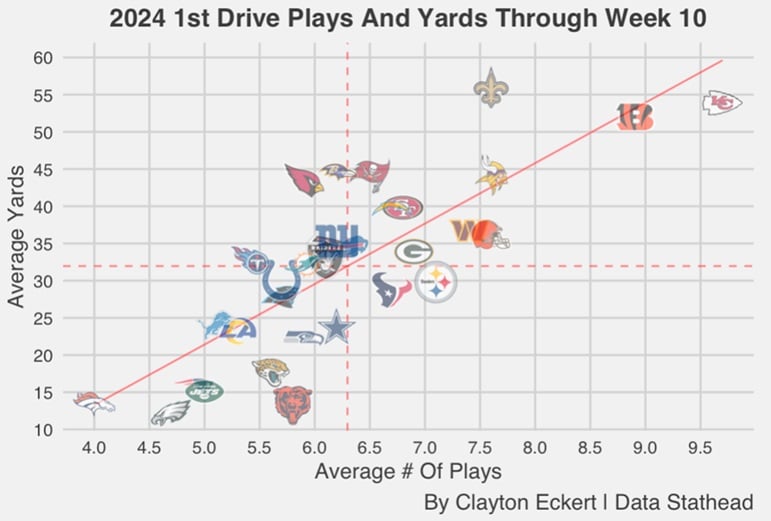
Pittsburgh’s offense has been above the mean with a 7.1 average number of plays on opening drives, which ranks seventh. That’s equated to a 3:37 average time of possession (T-10th). So, they’re not fizzling out as early or often as several other teams.
The bigger issues start with 29.8 average yards (20th), with their 27 average starting yard line (T-23rd) certainly not helping. Their strengths so far are a nice baseline, and weaknesses really point to needing to be stronger once they get into their own territory.
Some upcoming opponents fare well on the visual: Kansas City and Cincinnati in particular, Baltimore in yardage, and even Cleveland above average in both.
Next, let’s look at the outcomes of these drives more with scoring and turnover rates:
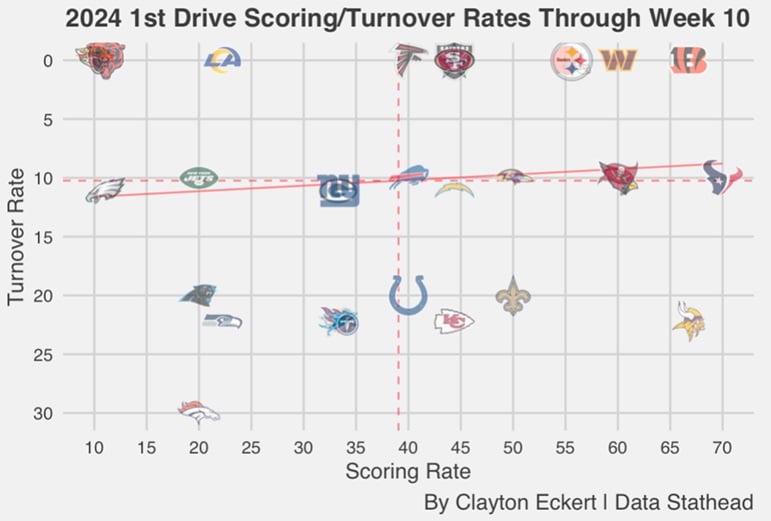

Here we see encouraging results, with Pittsburgh landing above the mean in each. They are one of several teams that have yet to turn the football over on an opening drive. The Steelers offense is also well above average in scoring at 55.6 percent which ties for seventh-best and may surprise people.
The rest of the AFC North is at or above the mean as well, and with all those games remaining, it could make opening drives a key component in those games.
Diving deeper, here are rates that zoom in on offensive production (removing field goals), touchdown and offensive turnover rates (interceptions and fumbles):
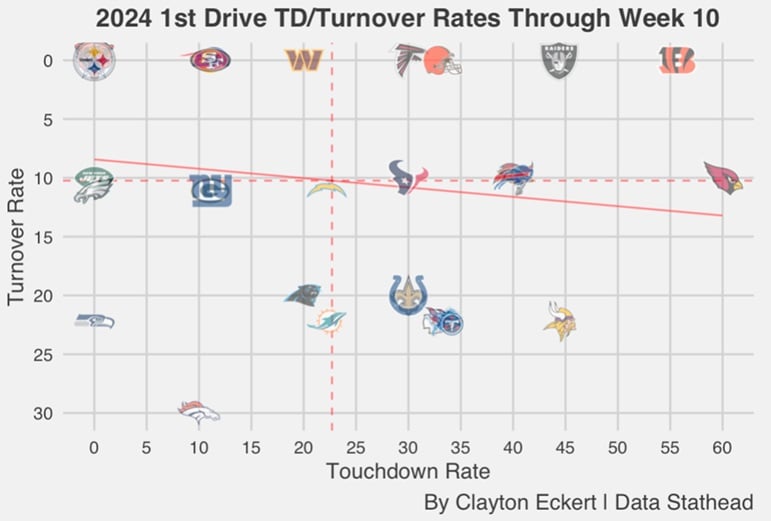

Sorry to burst the bubble of the previous visual, but Pittsburgh has yet to put it in the end zone on an opening drive through nine games. It hasn’t been dire considering the team’s 7-2 record, but could really help them reach a fuller potential as an offense.
Once again, the division is all at or above-average in both, scoring out of the gates early. It could play an unfortunate role if that continues, so hopefully Pittsburgh can flip this script starting this week against Baltimore.
On the other side of the coin, let’s briefly examine the opening drives that sputtered on offense, and ended in kicks (field goals or punts). I sorted lower numbers as good, since offensive touchdowns are the ultimate goal:
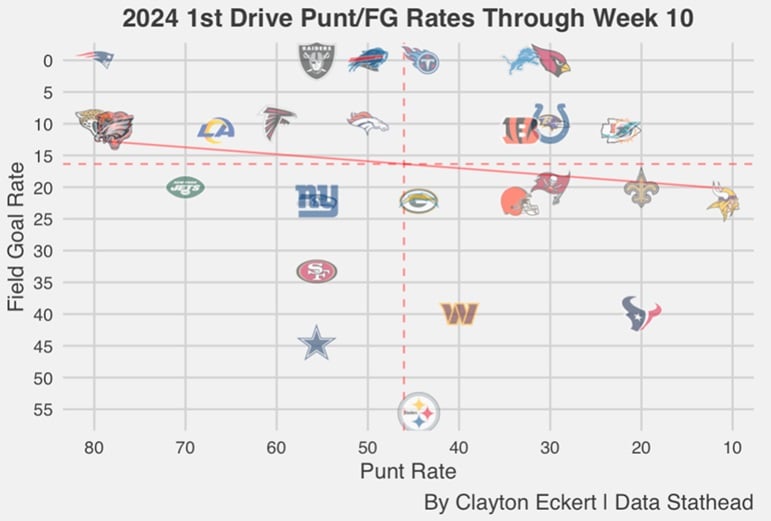

Very telling visual. Pittsburgh has relied on their kicker, the great Chris Boswell, more than any other team on opening drives. Their whopping 55.6 FG rate is the by far the most in the NFL, with second at 44.4-percent. This gives full context to their respectable scoring rate, none of which were touchdowns.
Of nine opening drives, five were Boswell FGs. While he is money, hope the Steelers get their first opening drive touchdown of 2024 against a potent Baltimore offense you don’t want to get down on the scoreboard against.
A 44.4 punt rate lands slightly above the NFL mean (T-14th), so while that could stand to improve, at least Pittsburgh is getting points more often than not. The Chiefs, Ravens, and Bengals all are all above average.
Let’s examine defenses now. Here are number of plays and average yards allowed, with lower numbers being good:
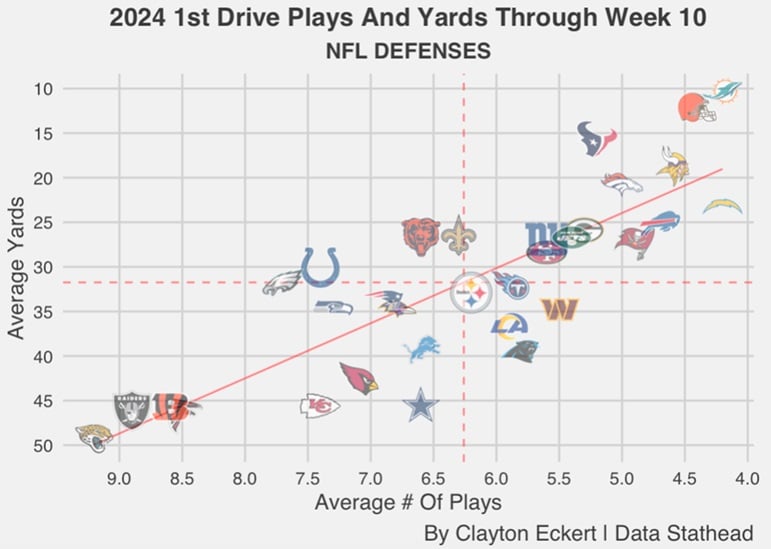

More often than not, Pittsburgh’s defense is a top 10 unit. Not on opening drives, with their 6.2 average number of plays allowed ranks 17th, and allowed 32.9 average yards allowed ranks 18th. Opposing offenses have a 29 average starting yard line (17th) and 3:19 average time of possession (18th). So very middling so far.
Cleveland lands well above-average, but the rest of Pittsburgh’s remaining opponents are largely below-average defenses in these terms. That could bode well for the Steelers offense potentially improving the rest of the way.
Here are defenses scoring and turnover rates:


Probably surprising to most (including myself), the Steelers defense is well below-average in both. They’ve allowed a 55.6 scoring rate, tying for 27th in the NFL, and haven’t created a turnover. That is much different than all situations, where Pittsburgh’s defense is second-best in the NFL in both scoring and turnover rates. High on my radar for hopeful improvement.
It’s also the worst balance than any remaining opponent, while the Ravens, Bengals, and Chiefs allowed similar scoring rates. Cleveland is the only NFL team that hasn’t allowed an opening-drive score all season, painful in comparison to Pittsburgh’s defense.
Now I’ll remove field goals, to see how defenses fared in touchdowns allowed:
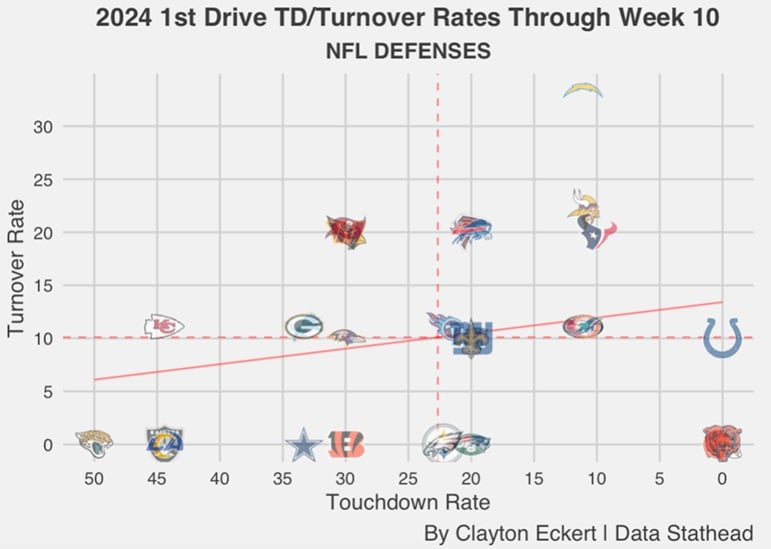

Thankfully, a 22.2-percent TD rate is a much better number, but still lands near the NFL mean and ties for 18th around the league. That lands with the upcoming Philadelphia defense, and aside from the Browns, the rest of Pittsburgh’s schedule is below-average in touchdown rates allowed.
So on paper, this leads to optimism to the hopeful improvements for the Steelers offense being realistic. But with the issues this team as had for quite some time, don’t show me the labor pains, show me the baby, as Dave likes to say.
And the other side of the coin, and ultimate defensive goal, getting stops. Here are punt and field goal rates:
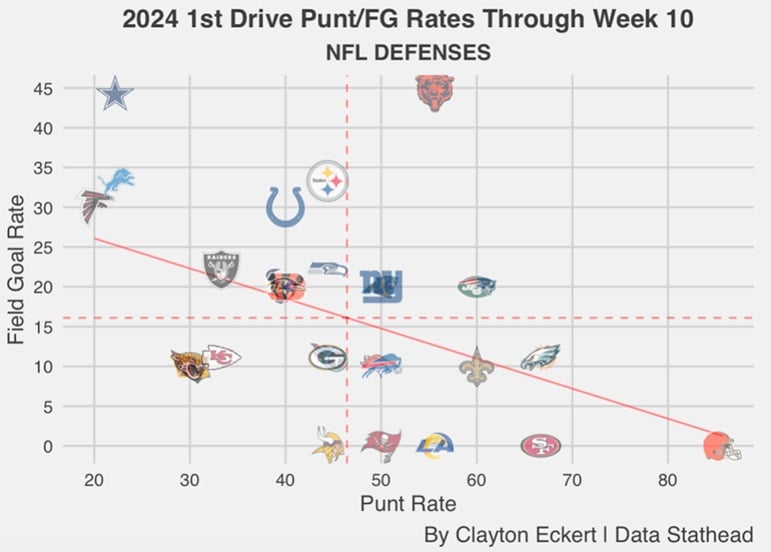

As you’d expect, with fewer touchdowns come more field goals forced. But that has been at one of the highest rates in the NFL at 33.3-percent (T-third). If forced to choose, that’s the preference, but another area the defense should look to improve the rest of 2024.
Speaking of which, they are also below the league mean in forcing teams to punt, at 44.4 percent of the time. To put that into context, Cleveland has forced the opposition into punts at an 85.7 percent rate, over 40 percent more than Pittsburgh.
The Ravens and Bengals land together on the top left, (higher FG rated allowed), but punt less often than Pittsburgh. The Eagles are quite good at forcing punts to start games. Kansas City is below the mean in each, allowing opponents to get going early and hang with them more than their history and unbeaten record would suggest.
While this is a small sample in the entirety of a game, and not high on HC Mike Tomlin’s list of keys, hopefully it will improve moving forward. Opening drives are a great barometer to feel out the oppositions plan, but hope Pittsburgh finds more success meanwhile the rest of the year, as they have after halftime and to close games overall.
To wrap up, here is a table of all the stat ranks (by season) compiled for the study:
| 2024 1st Drive Ranks | PIT OFF | PIT DEF |
| Avg. # Of Plays | 7 | 17 |
| Avg. Yards | 20 | 18 |
| Avg. Time | 10 | 18 |
| Avg. Yardline | 23 | 17 |
| Scoring Rate | 7 | 27 |
| Turnover Rate | 1 | T-last |
| Punt Rate | 14 | 16 |
| TD Rate | T-last | 18 |
| FG Rate | 1 | 3 |
This paints an overall picture of the strengths and weaknesses on opening drives for the Pittsburgh Steelers. The offense has moved the ball, controlled the clock, taken care of the football, and put up points at top-10 rates. That all sounds encouraging and is a great foundation. Improvements, namely TD rates (T-last), would make that feel better, along with average yard line and yards playing a role as well.
The defense fared worse than expected, unlike many stats they are top 10 in. The only mark on opening drives that fits the criteria is FG rate (third). Many average ranks, but most concerning is scoring rate (27th), and turnover rate (T-last). That is much different than all situations, where Pittsburgh’s defense is second-best in the NFL in both scoring and turnover rates.
If the Steelers can make strides the second half of the season, it could really help them be in control of more games and look like the Super Bowl contender some are already making them out to be. That would be fantastic, and fans heart rates would definitely thank them as well.















